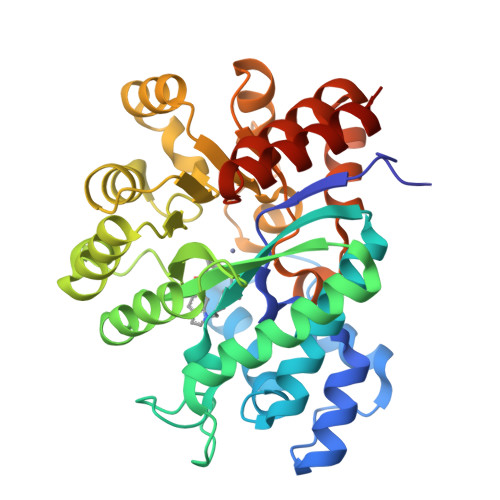Structure-based design, synthesis, and structure-activity relationship studies of novel non-nucleoside adenosine deaminase inhibitors
Terasaka, T., Kinoshita, T., Kuno, M., Seki, N., Tanaka, K., Nakanishi, I.(2004) J Med Chem 47: 3730-3743
- PubMed: 15239652
- DOI: https://doi.org/10.1021/jm0306374
- Primary Citation of Related Structures:
1O5R, 1QXL, 1UML - PubMed Abstract:
We disclose herein optimization efforts around the novel, highly potent non-nucleoside adenosine deaminase (ADA) inhibitor, 1-[(R)-1-hydroxy-4-(6-(3-(1-methylbenzimidazol-2-yl)propionylamino)indol-1-yl)-2-butyl]imidazole-4-carboxamide 1 (K(i)= 7.7 nM), which we recently reported. Structure-based drug design (SBDD) utilizing the crystal structure of the 1/ADA complex was performed in order to obtain structure-activity relationships (SAR) for this type of compound rationally and effectively. To utilize the newly formed hydrophobic space (F2), replacement of the benzimidazole ring of 1 with a n-propyl chain (4b) or a simple phenyl ring (4c) was tolerated in terms of binding activity, and the length of the methylene-spacer was shown to be optimal at two or three. Replacement of an amide with an ether as a linker was also well tolerated in terms of binding activity and moreover improved the oral absorption (6a and 6b). Finally, transformation of indol-1-yl to indol-3-yl resulted in discovery of a novel highly potent and orally bioavailable ADA inhibitor, 1-[(R)-4-(5-(3-(4-chlorophenyl)propoxy)-1-methylindol-3-yl)-1-hydroxy-2-butyl]imidazole-4-carboxamide 8c.
Organizational Affiliation:
Medicinal Chemistry Research Laboratories, Fujisawa Pharmaceutical Co., Ltd., 2-1-6, Kashima, Yodogawa-ku, Osaka 532-8514, Japan. tadashi_terasaka@po.fujisawa.co.jp




















